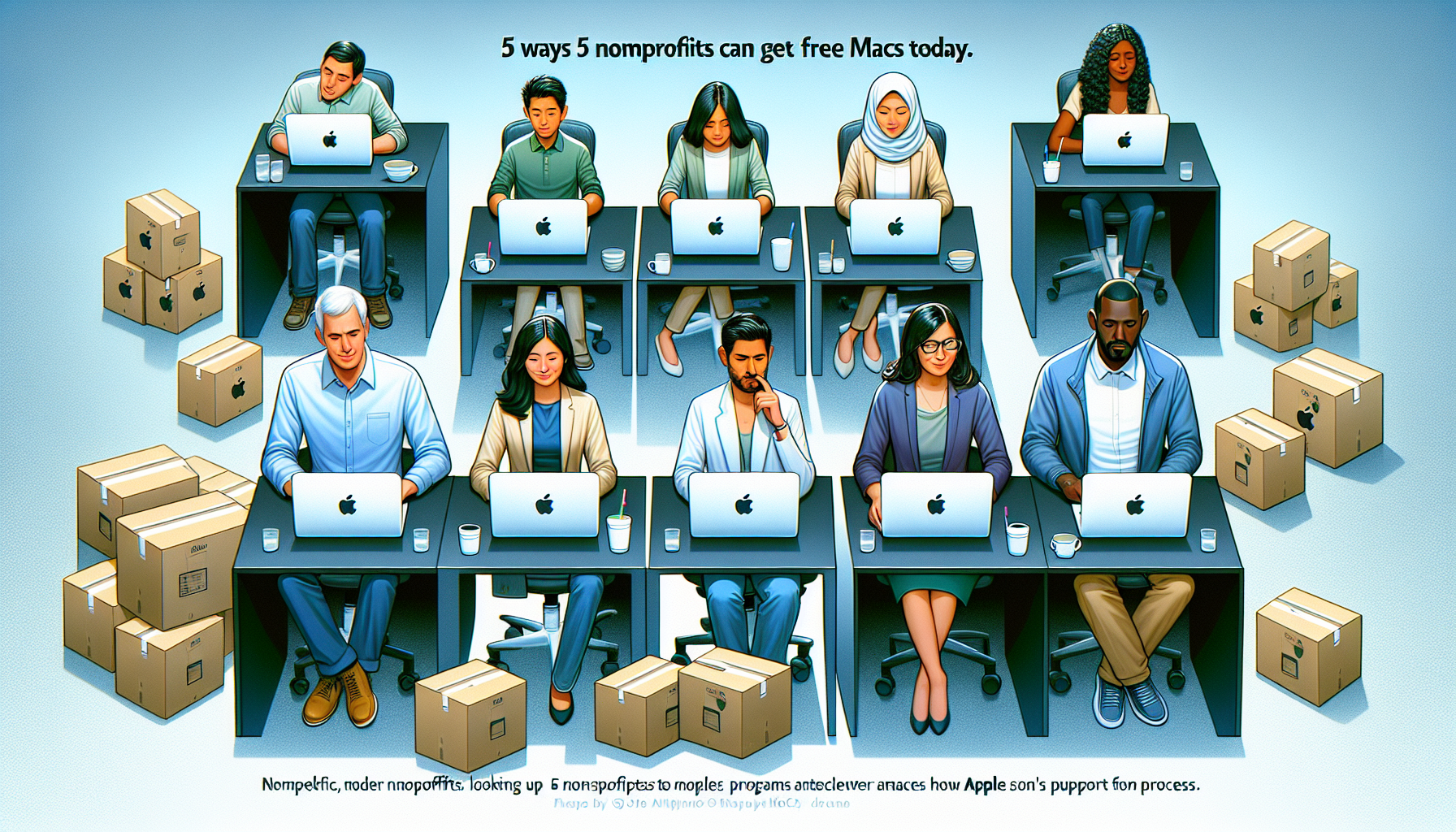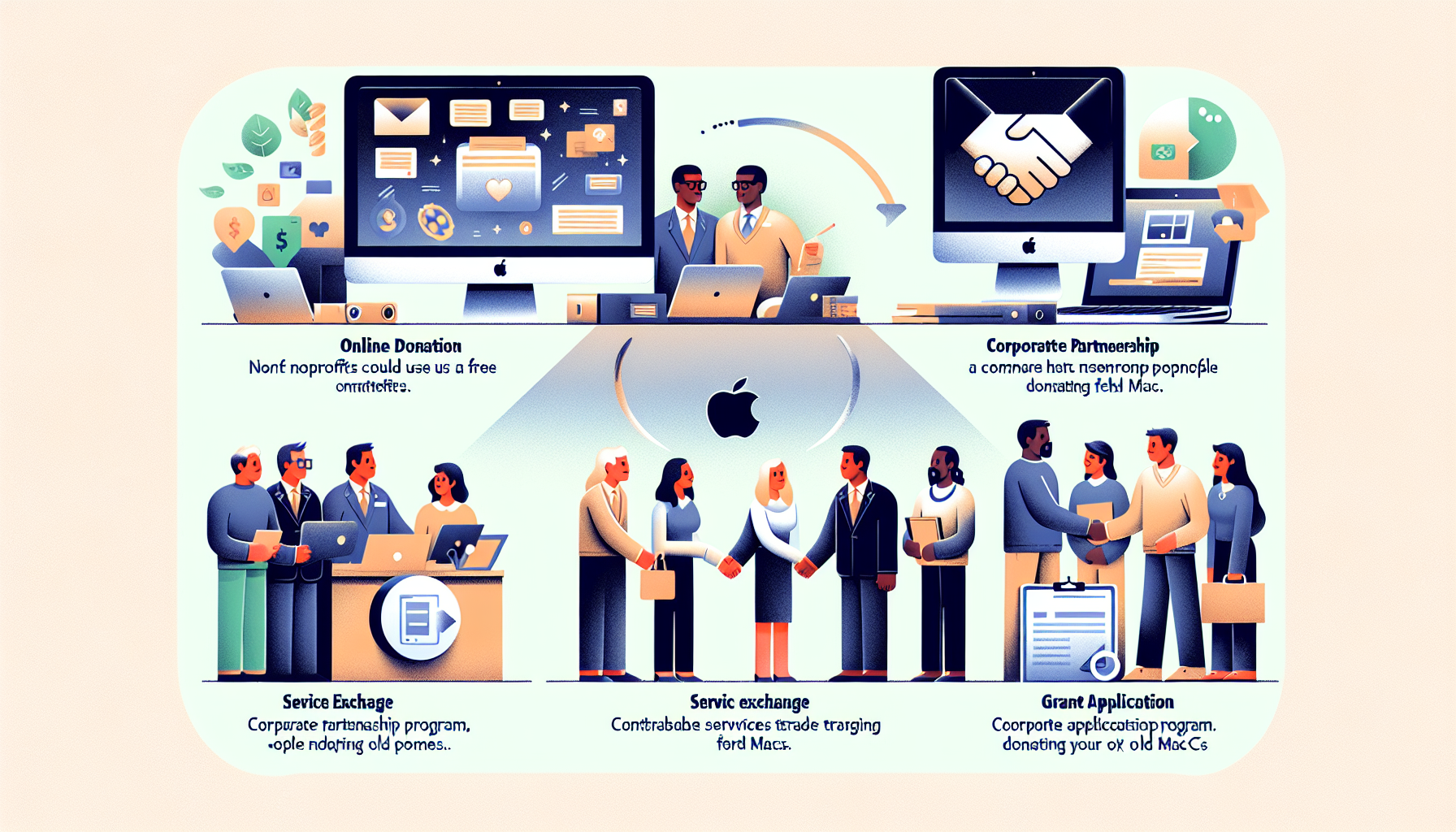Nonprofits often face tight budgets, making technology costs a significant burden. Many organizations struggle to keep up with the latest tools that can help them operate effectively. This is where the opportunity to get a free Mac comes in. By leveraging available resources, nonprofits can access valuable tech without straining their finances.
Here’s what this blog post will cover:
- The reasons why nonprofits can benefit from free Macs.
- How to research Apple’s donation programs.
- Utilizing TechSoup for affordable tech options.
- Exploring local grants and foundations for support.
- Partnering with other nonprofits for shared resources.
- Engaging social media campaigns to gather support.
Understanding the Need: Why Do Nonprofits Get a Free Mac?
Nonprofits operate on limited resources, making it tough to afford essential tools like computers. A free Mac can significantly enhance productivity and efficiency. Many organizations rely on outdated technology, which can hinder their ability to serve the community effectively.
Access to modern equipment allows nonprofits to streamline operations, improve communication, and enhance their outreach efforts. For instance, using a Mac can help with graphic design, video editing, and data management, all crucial for storytelling and fundraising.
Moreover, having up-to-date technology can attract more donors and volunteers. It shows potential supporters that the organization is serious about its mission. With numerous programs available for nonprofits, it’s worth exploring how to secure a free Mac today.
1. Research Apple’s Donation Programs
Many nonprofits may not realize that Apple has various donation programs aimed at supporting organizations like theirs. By researching these initiatives, nonprofits can discover opportunities to acquire free Macs and other devices. Apple is committed to giving back to the community, and their donation programs are designed to empower nonprofits with technology.
These programs often include grants and equipment donations, which can significantly reduce the financial burden on nonprofits. Engaging with Apple’s resources can lead to enhanced operational capabilities, allowing organizations to focus more on their missions rather than on managing tech expenses.

How Apple Supports Nonprofits
Apple supports nonprofits through its Apple Giving program, which provides donations of products and funds to eligible organizations. This initiative is part of Apple’s broader commitment to social responsibility and community engagement. The company believes in using its resources to help nonprofits achieve their goals.
Additionally, Apple collaborates with various nonprofit organizations to promote education, health, and social justice. By donating Macs and other devices, Apple enables nonprofits to access advanced technology, enhancing their ability to serve communities efficiently. This support can lead to improved communication, better project management, and more effective outreach efforts.
Eligibility Criteria for Donations
To qualify for Apple’s donation programs, nonprofits must meet specific eligibility criteria. Generally, organizations must be recognized as tax-exempt under section 501(c)(3) of the Internal Revenue Code. This ensures that the organization is legitimate and dedicated to charitable purposes.
Moreover, nonprofits may need to demonstrate a clear need for the technology. Apple looks for organizations that will utilize the donated Macs to make a positive impact in their communities. It’s essential for nonprofits to provide detailed information about their mission and how the technology will aid their operations. By meeting these criteria, nonprofits can increase their chances of receiving valuable support from Apple.
2. Check Out TechSoup
TechSoup is a fantastic resource for nonprofits looking to access technology at reduced costs. This organization partners with tech companies to provide discounted software, hardware, and services specifically tailored for nonprofits. By checking out TechSoup, organizations can find affordable options, including Macs, that can significantly enhance their operations.
TechSoup also offers valuable resources such as training, webinars, and support to help nonprofits maximize their technology use. This means that not only can organizations save money, but they can also gain knowledge on how to effectively implement and utilize the tools they acquire.
What is TechSoup?
TechSoup is a nonprofit organization that connects other nonprofits with technology resources. Founded in 1987, it aims to help organizations access the tools they need to succeed. Through partnerships with major tech companies, TechSoup provides discounted products and services to eligible nonprofits.
These offerings include everything from software licenses to hardware donations. For instance, nonprofits can often find deals on popular software like Microsoft Office or Adobe Creative Cloud. By leveraging TechSoup’s resources, organizations can stretch their budgets further while still obtaining essential technology for their missions.
How to Sign Up for TechSoup
Signing up for TechSoup is a straightforward process. First, nonprofits need to visit the TechSoup website and create an account. During registration, organizations must provide information about their nonprofit status, including their tax-exempt status and mission statement.
Once registered, nonprofits can browse available products and services. It’s important to review the eligibility requirements for each offering, as some may have specific criteria. After selecting desired items, organizations can complete the checkout process, often at a fraction of the retail price. By signing up for TechSoup, nonprofits can gain access to vital technology resources, including options for acquiring free Macs.
Available Mac Options Through TechSoup
TechSoup offers a variety of Mac options for nonprofits looking to enhance their technology without breaking the bank. Organizations can find refurbished Macs that are still powerful and reliable, making them suitable for everyday tasks. These devices come with significant discounts compared to retail prices, enabling nonprofits to stretch their budgets further.
Additionally, TechSoup often partners with Apple and other tech companies to provide access to the latest models. Nonprofits can explore options like MacBook Airs and MacBook Pros, depending on availability.

These Macs are ideal for various functions, including graphic design, data management, and communication. By choosing TechSoup, nonprofits not only save money but also gain access to quality technology that can help them better serve their communities.
3. Explore Local Grants and Foundations
Exploring local grants and foundations is another effective way for nonprofits to secure free Macs and other technological resources. Many local organizations and foundations are dedicated to supporting nonprofits in their communities by providing funding specifically for technology needs. By tapping into these resources, nonprofits can enhance their operations without incurring significant costs.
Local grant opportunities often have fewer applicants compared to national programs, increasing the chances of success. Nonprofits should actively research local foundations that align with their mission and goals. This can lead to valuable partnerships and support that extend beyond just technology, fostering community engagement and collaboration.
Finding Local Grant Opportunities
Finding local grant opportunities requires some research and networking. Nonprofits can start by checking websites like Foundation Center or GrantWatch, which list available grants by region. Additionally, local community foundations often have specific grant programs tailored to support nonprofits in their area.
Networking with other nonprofits can also yield valuable insights. Attending local nonprofit events or joining community groups can help organizations learn about new funding opportunities. Furthermore, utilizing platforms like LinkedIn can connect nonprofits with individuals who work in grant-making organizations. By being proactive and persistent, nonprofits can discover grants that provide essential funding for technology, including free Macs.
Examples of Foundations That Support Tech
Several foundations focus on supporting technology initiatives for nonprofits. For instance, the Bill & Melinda Gates Foundation offers grants aimed at improving education and technology access. Similarly, the W.K. Kellogg Foundation provides funding for projects that enhance community development and support nonprofits in leveraging technology.
Another notable example is the Knight Foundation, which invests in technology projects that foster informed and engaged communities. By researching these and other foundations, nonprofits can identify potential funding sources that align with their mission. Applying for grants from these foundations can lead to the acquisition of necessary tech resources, helping organizations operate more effectively.
Application Tips for Success
Applying for grants can be a competitive process, but there are several tips that can help nonprofits increase their chances of success. First, it’s crucial to carefully read the grant application guidelines. Understanding the specific requirements and objectives of the grant will allow organizations to tailor their proposals effectively.
Another key tip is to clearly articulate how the requested technology, such as a free Mac, will benefit the organization and the community it serves. Providing concrete examples and data can strengthen the case. Nonprofits should also highlight past successes and demonstrate their capacity to manage the funds responsibly.

Additionally, engaging with the funders before submitting an application can provide valuable insights. Many foundations appreciate when applicants reach out with questions or for clarification. This shows genuine interest and can help build a relationship with the funder. Lastly, submitting the application well before the deadline allows for any last-minute adjustments or corrections, ensuring a polished final proposal.
4. Partner with Other Nonprofits
Partnering with other nonprofits can be a powerful strategy for accessing free Macs and other resources. Collaborations allow organizations to pool their strengths and share costs, making it easier to secure technology and funding. By working together, nonprofits can amplify their impact and improve their chances of success in grant applications.
These partnerships can also lead to shared knowledge and best practices. When nonprofits collaborate, they can learn from each other’s experiences, which can enhance their operations and outreach efforts. Ultimately, partnering can create a stronger network of support within the nonprofit community, fostering innovation and resource sharing.
Benefits of Collaboration
Collaboration offers numerous benefits for nonprofits. One significant advantage is the ability to access a broader network of resources. By partnering with another organization, nonprofits can tap into new funding opportunities that may not have been available independently. This can include joint grant applications or shared technology resources.
Additionally, collaboration often leads to enhanced visibility and credibility. When two or more nonprofits work together, they can present a united front, attracting more attention from donors and stakeholders. This can result in increased funding and support for both organizations. Moreover, partnerships can help nonprofits reach new audiences, expanding their impact and effectiveness in the community.
Successful Partnership Examples
There are many successful partnership examples among nonprofits that highlight the benefits of collaboration. For instance, the American Red Cross and United Way often work together during disaster relief efforts. This partnership allows them to combine resources and expertise, resulting in more effective responses to crises.
Another example is the collaboration between Feeding America and various local food banks. By partnering, they can streamline operations, share technology, and better serve communities in need. These successful partnerships demonstrate how nonprofits can leverage each other’s strengths to secure valuable resources, including free Macs, ultimately enhancing their mission and impact.
How to Approach Potential Partners
Approaching potential partners requires a thoughtful and strategic approach. First, nonprofits should identify organizations that share similar missions or values. This alignment will make collaboration more meaningful and beneficial for both parties. Once potential partners are identified, it’s essential to research their work and understand how a partnership could be mutually advantageous.
When reaching out, nonprofits should initiate contact through a friendly email or phone call. Clearly express the intention to collaborate and outline the potential benefits for both organizations. It’s helpful to propose specific ideas for partnership, such as joint projects or shared resources, including the possibility of acquiring free Macs together.

Additionally, setting up a meeting can provide an opportunity for open dialogue. During this meeting, nonprofits can discuss their goals and explore how they can support each other effectively. Building a relationship based on trust and shared objectives is key to successful partnerships. By approaching potential partners with clarity and enthusiasm, nonprofits can create lasting collaborations that enhance their impact in the community.
5. Utilize Social Media Campaigns
Social media campaigns can be a game-changer for nonprofits looking to secure free Macs and other resources. By leveraging platforms like Facebook, Twitter, and Instagram, organizations can share their missions and connect with a broader audience. A well-crafted social media strategy can increase visibility and attract potential donors who are passionate about supporting nonprofit initiatives.
Moreover, social media enables nonprofits to engage with their communities in real-time. By sharing updates, success stories, and calls to action, organizations can foster a sense of community and encourage supporters to contribute. This engagement can lead to increased support, whether through donations, partnerships, or in-kind contributions like technology.
Creating a Compelling Story
Creating a compelling story is essential for effective social media campaigns. Nonprofits should focus on sharing narratives that resonate with their audience. This includes showcasing the impact their work has on the community and highlighting the need for resources, such as free Macs.
Visual storytelling is particularly powerful; using images and videos can capture attention and convey emotions more effectively than text alone. For instance, sharing testimonials from beneficiaries or showcasing volunteers in action can create a strong emotional connection. By crafting stories that inspire and motivate, nonprofits can drive engagement and spur action among their followers.
Engaging Your Audience
Engaging your audience on social media involves more than just posting updates. Nonprofits should actively interact with their followers by responding to comments, asking questions, and encouraging discussions. This two-way communication fosters a sense of community and makes supporters feel valued.
Additionally, nonprofits can host interactive campaigns, such as challenges or contests, to encourage participation. For example, a campaign could invite supporters to share their own stories related to the nonprofit’s mission. This not only boosts engagement but also expands the organization’s reach as followers share their posts with their networks. By creating a vibrant online community, nonprofits can enhance their chances of securing support, including free Macs, and ultimately further their mission.
Examples of Successful Campaigns
There are numerous examples of successful social media campaigns that have effectively engaged audiences and garnered support for nonprofits. One notable campaign is the #GivingTuesday initiative, which encourages people to donate to their favorite charities after the shopping frenzy of Black Friday and Cyber Monday. Many nonprofits leverage this day to create compelling stories and engage their followers, resulting in significant donations and support.

Another example is the Ice Bucket Challenge, which went viral and raised awareness and funds for ALS research. Participants filmed themselves pouring ice water over their heads, then challenged others to do the same while donating to the cause. This campaign not only spread awareness but also generated millions in donations, showcasing the power of social media to drive action.
Additionally, local nonprofits often run campaigns highlighting specific community needs. For instance, a food bank might share stories of families it helps, encouraging followers to donate food or funds. These successful campaigns demonstrate how storytelling and audience engagement can lead to substantial support, including the potential for acquiring free Macs and other essential resources.
Conclusion: Do Nonprofits Get a Free Mac?
In conclusion, the question of whether nonprofits can get a free Mac is a resounding yes. By exploring various avenues such as Apple’s donation programs, TechSoup, local grants, and partnerships with other nonprofits, organizations can access valuable technology without straining their budgets. Additionally, utilizing social media campaigns can help raise awareness and support for these initiatives, further enhancing their chances of success.
Recap of the Opportunities Available
To recap, here are the key opportunities available for nonprofits to secure free Macs:
- Apple’s Donation Programs – Explore Apple’s initiatives that support nonprofits through product donations.
- TechSoup – Access discounted and refurbished Macs tailored specifically for nonprofit needs.
- Local Grants and Foundations – Research local funding opportunities that focus on technology support for nonprofits.
- Partnerships with Other Nonprofits – Collaborate with like-minded organizations to share resources and apply for joint funding.
- Social Media Campaigns – Engage your audience and tell compelling stories to attract support and donations.
By leveraging these opportunities, nonprofits can enhance their operations and better serve their communities with the right technology in hand.
Frequently Asked Questions (FAQ)
Does Apple donate computers to nonprofits?
Yes, Apple does donate computers to nonprofits through various programs aimed at supporting charitable organizations. By researching Apple’s donation programs, nonprofits can find opportunities to receive free Macs and other devices that can significantly enhance their operations. Organizations should ensure they meet the eligibility criteria to qualify for these donations.
What do you get free with a MacBook?
When nonprofits acquire a MacBook through donation programs or initiatives like TechSoup, they often receive the device itself along with essential software that may come pre-installed. This can include productivity tools like Pages, Numbers, and Keynote. Additionally, nonprofits may be eligible for discounts on software and services that can help them maximize their technology use.
Does Apple give out grants?
While Apple does not typically provide direct grants to nonprofits, it supports various initiatives through donations and product contributions. Organizations can leverage Apple’s resources to access technology that can help further their missions. Nonprofits may also explore local foundations and grants that focus on technology support, which can complement Apple’s offerings.
How can nonprofits get free space?
Nonprofits can access free space through several avenues, including partnerships with local businesses or community organizations that offer meeting or office space. Additionally, various online platforms provide free cloud storage for nonprofits, enabling them to store and share files securely. By utilizing these resources, organizations can effectively manage their operations without incurring additional costs.



